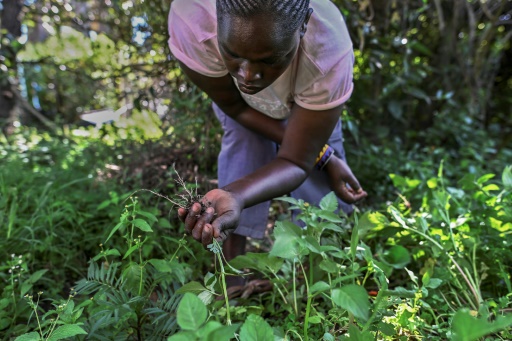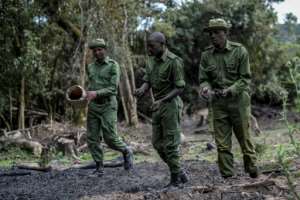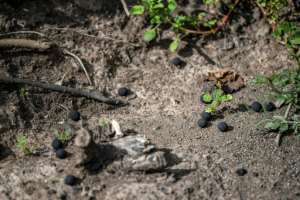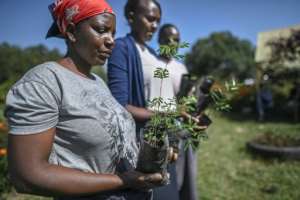
[ad_1]
At first glance, the round black pellets could easily be mistaken for animal droppings. But these sturdy little balls contain acacia seeds that help repel Kenya’s depleted forests.
In a slice of razed forest bordering the Masai Mara wildlife reserve, a team of rangers scatter generous handfuls of “seed balls” around the bald glade to give nature a chance to regenerate.
It only takes a few minutes for the eight rangers of the Mara Elephant Project, a conservation group, to toss some 22,000 seed balls into this ravaged corner of Nyakweri forest.
“It’s very simple,” said Jackson Maitai, whose guards discovered that loggers had illegally cleared this land during their routine patrols to protect elephants in the area.
“The seed balls are not really heavy. We just throw them wherever we see deforestation, so it’s not a big deal.”
As humble as they are, the seedballs are tackling a century-old problem in Kenya.
Trees were felled en masse by colonial administrators to power a train across East Africa, while land is now cleared for agriculture and charcoal production as the population of the Kenya is growing upwards and outwards.
The forests bordering the Masai Mara, the legendary wildlife refuge and wild savannah of the southwest of the country, are no exception, destroyed for pasture, crops and charcoal, a cheap fuel.
 The Rangers have given nature a helping hand by scattering seed balls by any means possible. By TONY KARUMBA (AFP)
The Rangers have given nature a helping hand by scattering seed balls by any means possible. By TONY KARUMBA (AFP) Nyakweri, for example, has lost more than 50 percent of its forest cover over the past two decades, reducing key habitats for wildlife, according to Marc Goss, director of the Mara Elephant Project.
But forests, which cover only seven percent of Kenya’s land mass, also act as water reserves and a powerful bulwark against climate change and desertification.
Kenya’s forests are cleared at the rate of 5,000 hectares (12,300 acres) per year, the Environment Ministry said in 2018.
Ancient technique
For the past three years, Goss and his team have been helping nature by scattering seed balls by any means possible – on foot, by car, and even by helicopter.
Developed by Seedballs Kenya, the charcoal dust husk protects the seed inside from being eaten by mice, birds or insects before it germinates. The hull is semi-porous, which gives it a fighting chance even in arid conditions.
 The charcoal dust cover protects the seed inside from being eaten by mice, birds or insects before it germinates. By TONY KARUMBA (AFP)
The charcoal dust cover protects the seed inside from being eaten by mice, birds or insects before it germinates. By TONY KARUMBA (AFP) “You can throw them all year round. It just stood there, waited for the rain to come, it washes away the dust, then the seed came back to its natural state and can start to grow,” said Teddy Kinyanjui. , the co-founder of Seedballs Kenya.
The idea isn’t entirely new: In ancient Egypt, the seeds were covered in mud to protect them from the elements and hungry passers-by, Kinyanjui said.
But instead of mud, innovation in Kenya uses cheap and abundant charcoal dust to forge their own gut.
The dust used to compose the pellets is a byproduct of the charcoal industry, which itself drives deforestation, with felled trees being slowly heated in kilns to produce the popular and inexpensive fuel.
“It’s kind of a closed-loop cycle,” Kinyanjui said.
The seed balls contain only native species, mainly varieties of acacias, a classic tree of the East African savannah, but much sought after and felled for the quality of its wood.
Slow and steady
In Kenya, seed balls are bought by smallholder farmers who want a cheap way to green their land, and major buyers donate 500 kilograms (1,100 pounds) at a time to groups working in reforestation, such as the Mara Elephant Project. .
 The seed balls contain only native species, mainly varieties of acacia, the classic tree of the East African savannah. By TONY KARUMBA (AFP)
The seed balls contain only native species, mainly varieties of acacia, the classic tree of the East African savannah. By TONY KARUMBA (AFP) Seedballs Kenya, which reinvests its profits, also works with hotels offering tourists a “reforestation” experience to accompany the traditional safari.
The company has sold 13 million seed balls since its launch in mid-2016.
Of those who were dumped in the wild, only a small number – somewhere in the 5-10% range – actually gave a sprout.
The germination rate is low and some seeds can hibernate for years – making visible gains for a long time, Kinyanjui said.
“Trees are slow, especially nowadays where everything is Instagram and fast, fast, fast,” Kinyanjui said.
“Telling people to wait three years, or whatever, is a very difficult thing.”
Source link